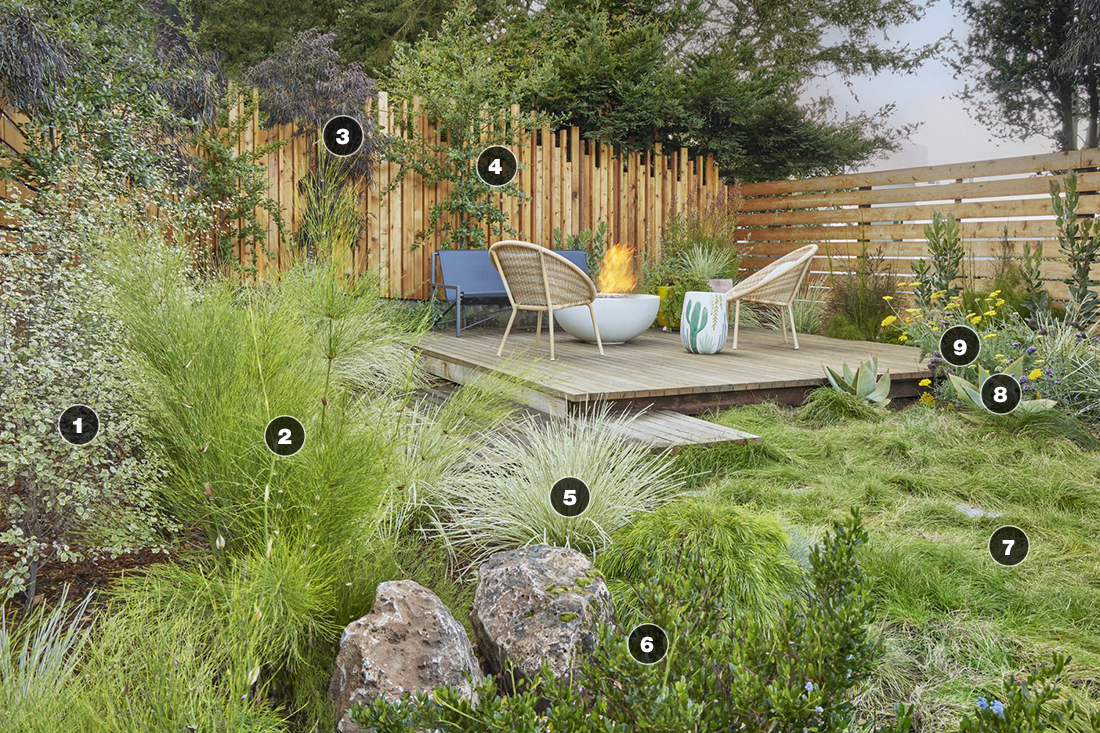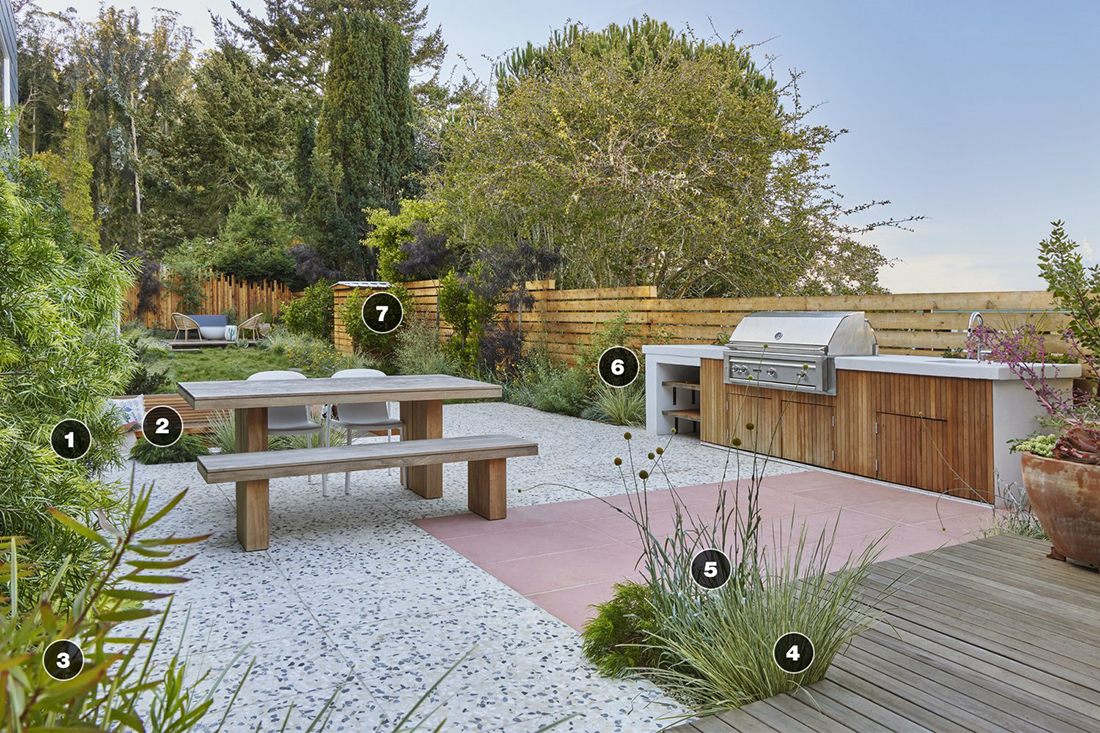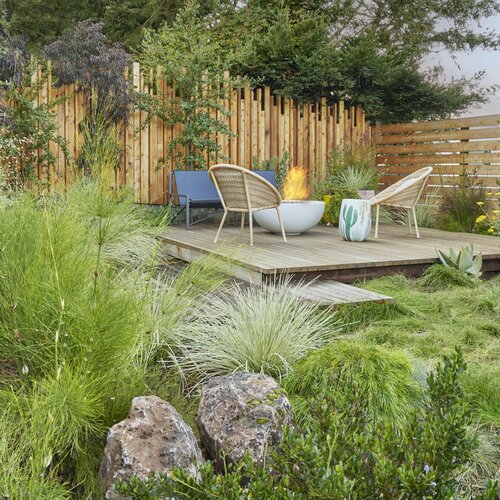
Choosing great-looking plants that are well-adapted to a garden’s unique light and soil conditions will always be a challenge, and the variables presented by San Francisco’s diverse microclimates and topography make the task even trickier. However, the Bay Area gardens designed by Dani Coulter of Friday Gardens exude a casual elegance that belies the diligent research and effort that have gone into finding the perfect plants for each site. The stylish outdoor rooms that she designs blur the line between home and garden.
Learn more about the three gardens that were featured in the cover story of Fine Gardening’s summer 2025 issue here.
1. ‘Silver Sheen’ pittosporum (Pittosporum tenuifolium ‘Silver Sheen’, Zones 8–11)
2. Horsetail restio (Elegia capensis, Zones 9–11)
3. ‘After Dark’ peppermint willow (Agonis flexuosa ‘After Dark’, Zones 9–11 )
4. ‘Concha’ California lilac (Ceanothus ‘Concha’, Zones 7–10)
5. Platinum Beauty® lomandra (Lomandra longifolia ‘Roma13’, Zones 8–10)
6. ‘Yankee Point’ California lilac (Ceanothus griseus horizontalis ‘Yankee Point’, Zones 8–11)
7. No-mow mix of California native fescues (Festuca idahoensis, rubra, and F. occidentalis, Zones 4–10).
8. Coral aloe (Aloe striata, Zones 9–11)
9. ‘Moonshine’ yarrow (Achillea ‘Moonshine’, Zones 3–8)
1. African fern pine (Afrocarpus gracilio Podocarpus glacilior, Zones 9–11)
2. Cousin Itt acacia (Acacia cognata ‘ACCOG01’, Zones 9–11)
3. ‘Safari Sunset’ cone bush (Leucadendron ‘Safari Sunset’, Zones 9–11)
4. Platinum Beauty® lomandra (Lomandra longifolia ‘Roma13’, Zones 8–10)
5. Billy Buttons (Craspedia globosa, Zones 8–11)
6. Manzanita (Arctostaphylos, Zones 8–10)
7. Meyer lemon (Citrus x meyeri, Zones 9–11)
1. Blue oat grass (Helictotrichon sempervirens, Zones 4–8)
2. Foxtail agave (Agave attenuata, Zones 10–11)
3. Buttercup the rabbit🐰 (Oryctolagus cuniculus ‘Buttercup’)
4. Platinum Beauty® lomandra (Lomandra longifolia ‘Roma13’, Zones 8–10)
5. Platinum Beauty® lomandra (Lomandra longifolia ‘Roma13’, Zones 8–10)
6. Tree germander (Teucrium fruticans, Zones 8–10)
1. Mediterranean fan palm (Chamaerops humilis, Zones 9–11)
2. Kohuhu (Pittosporum tenuifolium, Zones 8–11)
3. Horsetail (Equisetum hyemale, Zones 4–9)
4. Smoketree (Cotinus coggygria, Zones 4–9)
5. Pittosporum (Pittosporum tenuifolium , Zones 8–11)
6. Artichoke (Cynara cardunculus, Zones 7–10)
7. Blue oat grass (Helictotrichon sempervirens, Zones 4–8)
8. White licorice (Helichrysum petiolare, Zones 9–10)
9. Platinum Beauty® lomandra (Lomandra longifolia ‘Roma13’, Zones 8–10)
10. Tree germander (Teucrium fruticans, Zones 8–10)
1. Wooly thyme (Thymus pseudolanuginosus, Zones 5–8)
2. Blue fescue (Festuca glauca, Zones 4–9)
3. ‘Silver Falls’ silver ponysfoot (Dichondra argentia ‘Silver Falls’, Zones 10–12)
4. California blue sage (Salvia clevelandii, Zones 8–10)
5. Spiny-headed mat rush (Lomandra longifolia, Zones 8–10)
6. California blue sage (Salvia clevelandii, Zones 8–10)
7. Breeze mat rush (Lomandra longifolia ‘LM300’, Zones 8–11)
8. Spiny-headed mat rush (Lomandra longifolia, Zones 8–10)
9. Cone bush (Leucadendron Zones 9–11)
10. Bell reed (Cannomois grandis, Zones 9–11)
11. Queen’s crape myrtle (Lagerstroemia speciosa, Zones 10–12)
Read more about this garden in 3 Takes on a Contemporary Backyard by Dani Coulter
Carol Collins is the editor of Fine Gardening magazine.
Fine Gardening Recommended Products
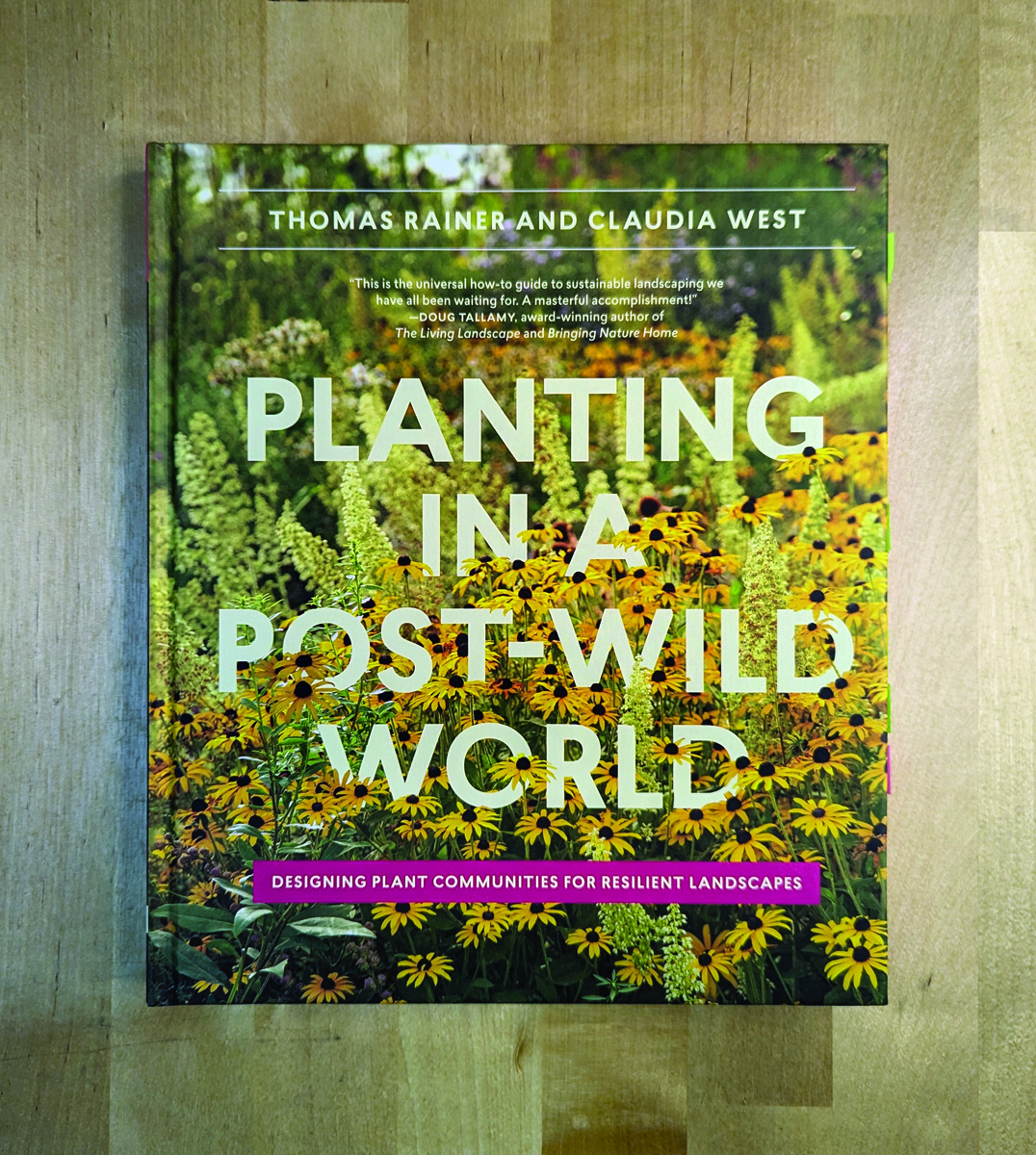
Planting in a Post-Wild World: Designing Plant Communities for Resilient Landscapes
Fine Gardening receives a commission for items purchased through links on this site, including Amazon Associates and other affiliate advertising programs.
Featuring gorgeous photography and advice for landscapers, Planting in a Post-Wild World by Thomas Rainer and Claudia West is dedicated to the idea of a new nature—a hybrid of both the wild and the cultivated—that can nourish in our cities and suburbs.
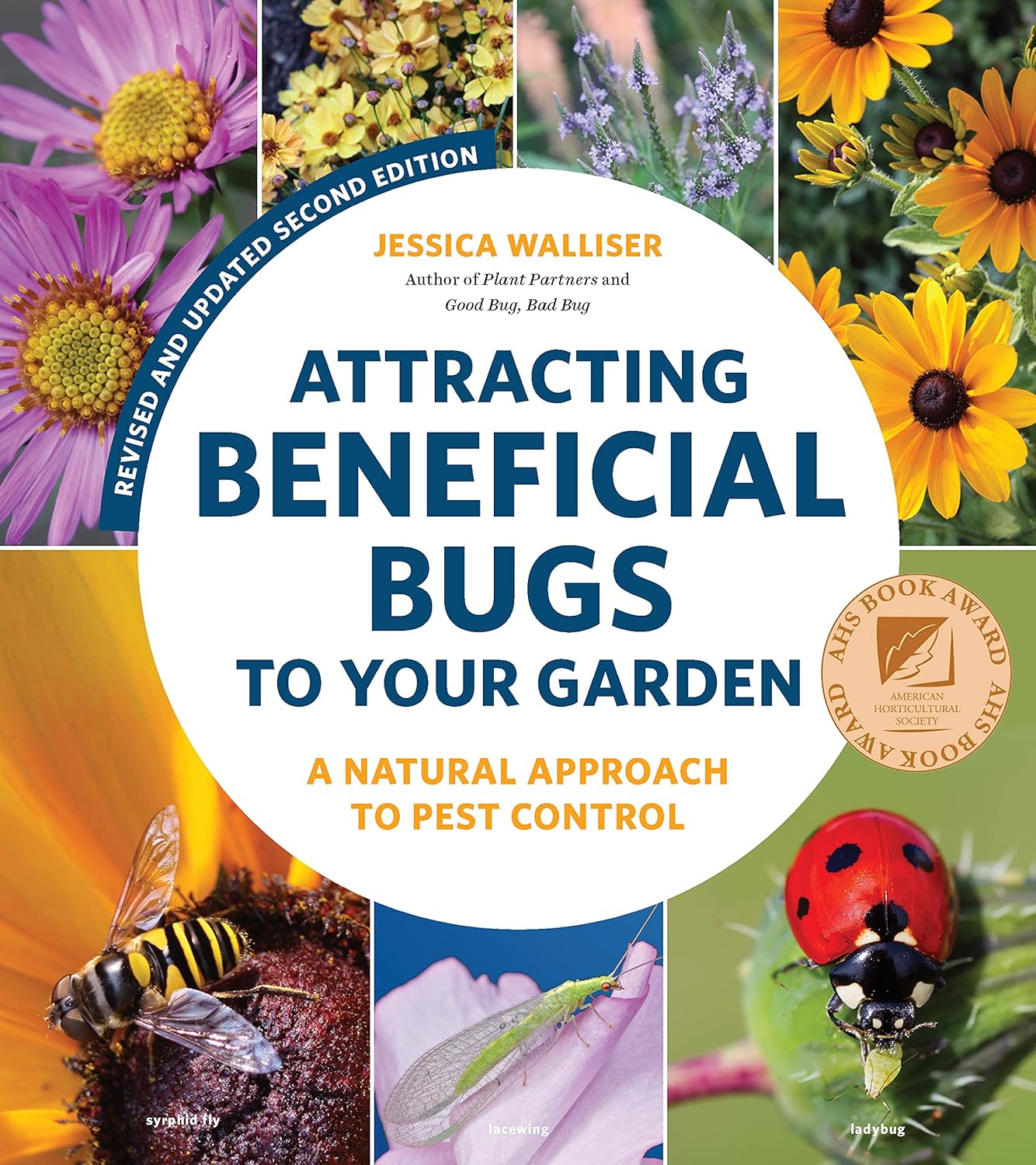
Attracting Beneficial Bugs to Your Garden, Revised and Updated Second Edition: A Natural Approach to Pest Control
Fine Gardening receives a commission for items purchased through links on this site, including Amazon Associates and other affiliate advertising programs.
This revised and updated edition of Jessica Walliser’s award-winning Attracting Beneficial Bugs to Your Garden offers a valuable and science-backed plan for bringing balance back to the garden. With this indispensable gardening reference—now updated with new research, insights, and voices—learn how to create a healthy, balanced, and diverse garden capable of supporting a hard-working crew of beneficial pest-eating insects and eliminate the need for synthetic chemical pesticides.
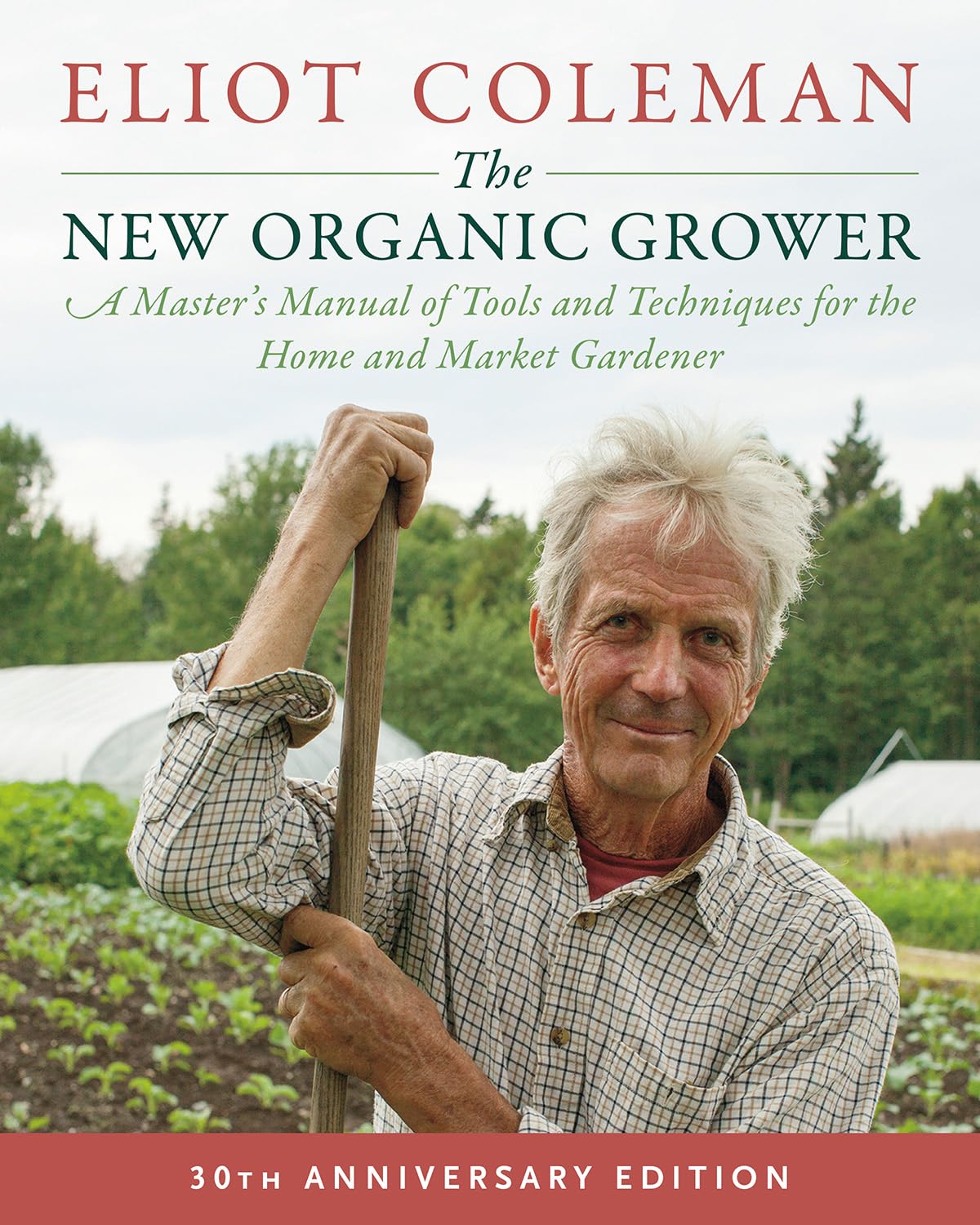
The New Organic Grower, 3rd Edition: A Master’s Manual of Tools and Techniques for the Home and Market Gardener, 30th Anniversary Edition
Fine Gardening receives a commission for items purchased through links on this site, including Amazon Associates and other affiliate advertising programs.
Since its original publication in 1989, The New Organic Grower has been one of the most important farming books available, with pioneer Eliot Coleman leading the charge in the organic movement in the United States. Now fully illustrated and updated, this 30th Anniversary Edition is a must-have for any agricultural library.

